Painted in 1797, or year V in France’s Revolutionary calendar,1 this intimate half-length portrait by François-André Vincent depicts the 51-year-old sculptor Philippe Laurent Roland (1746–1816). Roland was an exact contemporary and longtime friend of Vincent’s who had recently become his colleague in the Institut, which had been established in 1795 to replace the recently abolished Royal Academy.2 Vincent shows Roland from the side, sitting with his body turned slightly toward the viewer and his proper right arm resting casually on the back of his chair. His hand, dominating the center foreground, lightly grips an ébauchoir, a sculptural tool used for working plaster.3 The artist’s dress, consisting of a well-worn jacket, plain waistcoat, and loose shirt with a pleated frill, is decidedly simple, informal, and unpretentious. His powdered hair slightly disheveled, Roland directly engages us, his expression finely nuanced. His level gaze is cool and restrained, perhaps even faintly quizzical in his calm appraisal of the viewer, his brow slightly furrowed. Yet his demeanor also conveys warmth, his parted lips heightening our sense of an intelligent character caught in the moment, his guard lowered in a friendly encounter between peers.
Vincent’s restricted palette is likewise subtly nuanced, ranging from the cool, light grays of the background, the warm browns of Roland’s jacket and the creams and whites of his waistcoat and shirt, to the ruddy flush of his cheeks and the red of the honorific ribbon pinned to the inside of his jacket, offering a counterpoint to the dull green of the chair back. Vincent’s command of his medium is evident throughout, from the lightly brushed background that imparts a wonderful sense of atmosphere, to the firm, indeed sculptural modeling of Roland’s head and hand, whose three-dimensionality is emphasized by the painter’s modulation of light and shade. The resulting sense of physical immediacy, of vital presence, is impressive, and is further emphasized by the tight framing of the composition, the proximity of the sitter to the picture plane, and the suppression of superfluous details.
By 1798, when he exhibited this portrait in the Paris Salon,4 Vincent was an eminent figure in the French art world whose public career dated back some three decades. His had been the model academic trajectory. As a precocious teenager in the early 1760s he had enrolled in the studio of Joseph-Marie Vien (1716–1809), where he proved an exemplary student, eventually winning the Royal Academy’s Grand Prix in 1768, six years ahead of his contemporary Jacques-Louis David (1748–1825), who was also a pupil of Vien’s.5 This award entitled Vincent to study for several years at the École des Elèves protégés, which had been established to further the humanistic education of Grand Prix winners,6 and then embark on a trip to Rome, where he would be a pensionnaire at the French Academy in the Palazzo Mancini from 1771 to 1775.7 Soon after his return to Paris, he was formally accepted (agrée) into the Academy,8 eventually becoming a full member in 1782 with his reception piece, The Abduction of Orythia, a dramatic mythological scene.9 This was followed by his appointment in 1785 as adjunct professor,10 and then in 1792, in the midst of the Revolution, as full professor at the Academy, not long before the institution was abolished.11 When, after the Thermidorian Reaction, the Institut national des Sciences et des Arts was created in 1795, effectively replacing the old Academy, Vincent was among the founding members of the Literature and Fine Arts section.12 In his later years he would become such an integral figure to the Institut that pupils of David took to calling it the “Académie Vincent”!13
Paralleling Vincent’s rise in the institutional ranks was his noteworthy career in the Salon, where he proved to be one of the most ambitious, inventive, and versatile painters of his generation, and for a period was considered David’s main rival. While large-scale history paintings dominated Vincent’s Salon exhibits and consumed much of his energy, he nonetheless demonstrated an inclination toward portraiture. Personal ties doubtlessly played a role here, as Vincent was not only the son of the well-regarded miniature painter and portrait specialist François Élie Vincent (1708–1790),14 but he was also the onetime teacher, then romantic partner, and eventually husband of one of the most prominent portraitists of the day, Adélaïde Labille-Guiard (1749–1803).15
Vincent’s own talents in the genre manifested themselves early on in the brilliant portraits-charges (caricatural portraits) that he drew of his fellow pensionnaires at the French Academy in Rome.16 The director at the time, Charles-Joseph Natoire (1700–1777), who witnessed Vincent’s work on early paintings like the 1775 Portrait of Monseigneur Ruffo,17 underscored Vincent’s great promise as portraitist, reporting that same year to the comte d’Angiviller (1730–1809), the director of the Bâtiments du Roi (essentially the Culture Minister): “Our students are all working zealously. Vincent has recently made some portraits showing very good taste; it seems to me that this will be the area in which he should most like to occupy himself.”18
Portraiture certainly played an important part in Vincent’s Salon career following his return to Paris. Between 1777, the year of his Salon debut, and 1801, the year of his final Salon, he exhibited fourteen paintings that were identified as portraits.19 These represent more than a quarter of his total Salon production, which amounted to at least forty-nine paintings. Portraits of artist friends form a notable subset of these Salon pictures, from the portraits of the painter Jean-Simon Berthélemy (1743–1811) and the architect Pierre Rousseau (1751–1829), both shown in the 1777 Salon, to the portrait of the dramatist Pierre Jean Baptiste Choudard, known as Desforges (1746–1806), shown in the 1791 Salon, and ultimately the portrait of the sculptor Roland, shown in 1798.20 The friendship ties to which these portraits bore fraternal witness were vital to Vincent’s own self-image, reflecting as they did his own status and position in contemporary artistic life.
For his part, Roland had become a figure of considerable distinction by the late 1790s, though his trajectory had certainly been more irregular and less conventionally academic than Vincent’s. Born near Lille in 1746, he emerged from a humble artisanal context. By 1764 he had moved to Paris and entered the sculpture studio of Augustin Pajou (1730–1809), an influential academician who would have a determining effect on his career. Roland gained invaluable practical experience by working with Pajou on important decorative commissions for the monarchy during the 1760s, most notably at the Palais Royal and Château de Versailles.21 Through such work he earned enough to pay his own way to Italy, where he enjoyed a five-year sojourn from 1771 to 1776, which coincided with Vincent’s own time in Italy. “It is as if [Roland] conferred upon himself his own Prix de Rome but without feeling the same constraints as the pensioners of the Académie,” James David Draper has aptly remarked.22 If Vincent and Roland had not yet become friends during this period, they were certainly well acquainted by the time Vincent attended Roland’s nuptials in 1782.23
Upon Roland’s return to Paris, he became Pajou’s practitioner of preference, entrusted with translating his former master’s models into marble,24 and he soon embarked upon his own official academic career with Pajou’s strong encouragement. In 1782, the year that Vincent became a full member, Roland was accepted (agrée) into the Royal Academy, and the following year he submitted a sketch for his official reception piece, Samson. He never moved past the rank of agrée, however, as the final marble version of this sculpture was finished only after the Academy was suppressed in 1793.25 Contributing to this delay were a number of important projects that commanded Roland’s attention in the 1780s. Thanks to Pajou’s influence, for example, he received a commission for a full-length statue of Louis II, Prince de Condé, which was to be part of the series celebrating great Frenchmen conceived by the Comte d’Angiviller.26 And thanks to his father-in-law, Nicolas-Marie Potain (1713–1796), royal architect and comptroller of works at the chateau de Fontainebleau, he received a commission to provide sculptural decorations in the private apartments of Louis XVI and Marie Antoinette.27 With the Revolution, Roland adapted to political circumstance and set to work on some allegorical representations on the Republican theme of Law for the Pantheon.28 Though he had never become a full member of the Academy, his experience and stature were such that he would be one of the founding members of the new Institut along with Vincent in 1795;29 it was that same year that he finally exhibited his marble version of Samson in the Salon.30
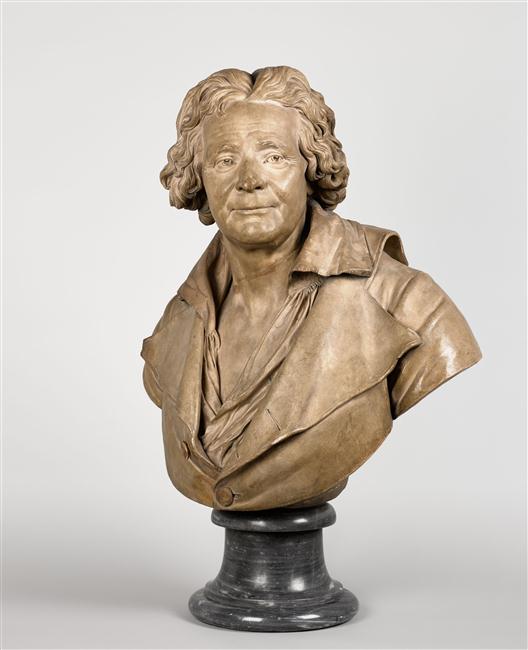
Like Vincent, Roland was a versatile talent who demonstrated an aptitude for portraiture, and who exhibited portraits, both busts and medallions, on numerous occasions in the Salon.31 Perhaps the most personally meaningful of these, a plaster bust of his master, mentor, and friend Pajou, was shown in the 1798 Salon (to be followed by a final marble version in 1800) (fig. 1). The resonance between Roland’s portrait of Pajou and Vincent’s portrait of Roland is immediately apparent, in their sober realism, sympathetic characterizations, and similarly informal dress. It was a sculptor very much in the mold of the venerable Pajou that Vincent was presenting in his depiction of Roland.32
To grasp the public import of Vincent’s portrait in 1798, an understanding of the turbulent history of the Salon in the wake of the Revolution is key. In 1791, the Salon was democratized and liberty was the new watchword. Open to all talents, it was no longer the exclusive precinct of the privileged members of the Royal Academy, Vincent and Roland among them. In the Salon catalogue, artists would no longer be listed in order of their academic rank, but according to the far more arbitrary arrangement of the Salon hang (meaning that an individual artist’s submissions were dispersed throughout the catalogue). Furthermore, no titles of distinction would accompany artists’ names, and these names would follow rather than precede the title of the artworks, the idea being that works were to be judged exclusively on their merits, rather than on the basis of their maker’s status and reputation. The message was clear: established artists were up for critical reevaluation and formerly privileged academicians had to prove themselves on a new, level playing field.33
The consequences of this revolution in the Salon were not surprising. There was a dramatic spike in the number of artists exhibiting and the number of works exhibited.34 The hierarchical supremacy of history painting was challenged by a rising tide of work in the lesser genres, portraiture included.35 Even more troubling was the influx of poor, substandard paintings — widely denigrated as “croûtes,” or daubs.36 These threatened the very credibility of the Salon, leading numerous artists to abstain from exhibiting, which in turn depressed visitor numbers.
The backlash was swift. By the mid-1790s there was widespread agreement that new reforms and quality controls were urgently required to help maintain France’s cultural status. In 1795, to address the egalitarian disarray of the catalogue, artists were grouped by medium and listed alphabetically, with an individual artist’s submissions once again listed all together under his or her name.37 In 1796, artists’ names would be accompanied for the first time by those of their masters, providing a kind of external guarantee of the work’s quality.38 Most importantly, a jury was instituted for the selection of works, in response to vociferous demands by the artists themselves.39 The 1798 Salon was the first of the post-Revolutionary Salons with an admission jury, and the results were immediately apparent. Mediocre artists were discouraged from submitting, and established talents were encouraged once again to put themselves forward. The number of works on display was substantially reduced,40 overall quality was perceptibly improved, and attendance figures were up dramatically (judging by the catalogue sales).41 There was a clear consensus that, thanks to the new meritocratic principles governing its organization, the 1798 Salon was the best of the decade.42
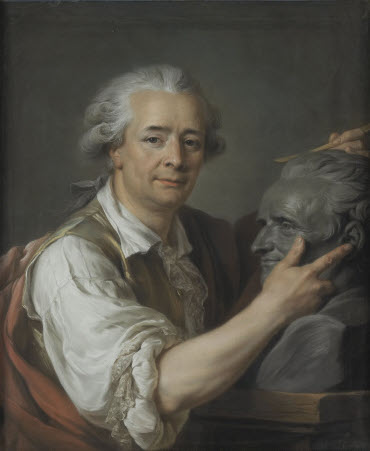
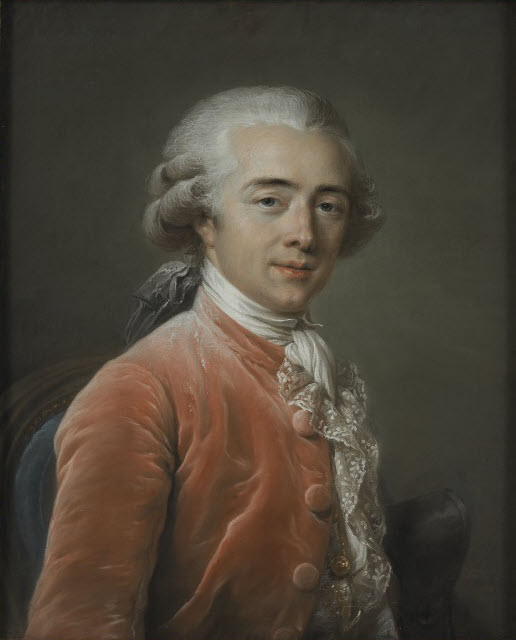
The tension between democratic egalitarianism and meritocratic elitism that the Salons of the 1790s brought to the fore also informs Vincent’s portrait of Roland and its public presentation. In many ways the painting is emblematic of the democratic tendencies in Revolutionary-era male portraiture. The emphasis is upon capturing the model’s physiognomy and character in a frank and candid manner. The elaborate décor that traditionally might have spoken to his wealth, social position, tastes, and occupation has been dispensed with, the artist opting instead for a plain, light-toned background that simply highlights the figure, whose only professional attribute in this case is the humble wooden ébauchoir. Roland’s pose likewise reads as natural and unaffected. There is none of the rhetorical emphasis of gesture which persisted in ancien régime portraiture; Labille-Guiard’s pastel portrait of Roland’s master Pajou, executed in 1782, provides an instructive point of comparison here (fig. 2). A related shift is evident in Roland’s sober dress. The brightly colored velvets and ornamental lace that we still see, for example, in Labille-Guiard’s 1782 portrait of Vincent (fig. 3), have given way to simple brown cloth, plain linen, and a deliberate négligence of self-presentation. This sartorial revolution, already gathering momentum in the 1770s and 1780s, promoted notions of freedom and naturalness, in keeping with the philosophical ideas of Jean-Jacques Rousseau and in democratic opposition to the artificial strictures and sumptuary codes associated with court culture. Dispensing with wigs was part of this trend as well.43
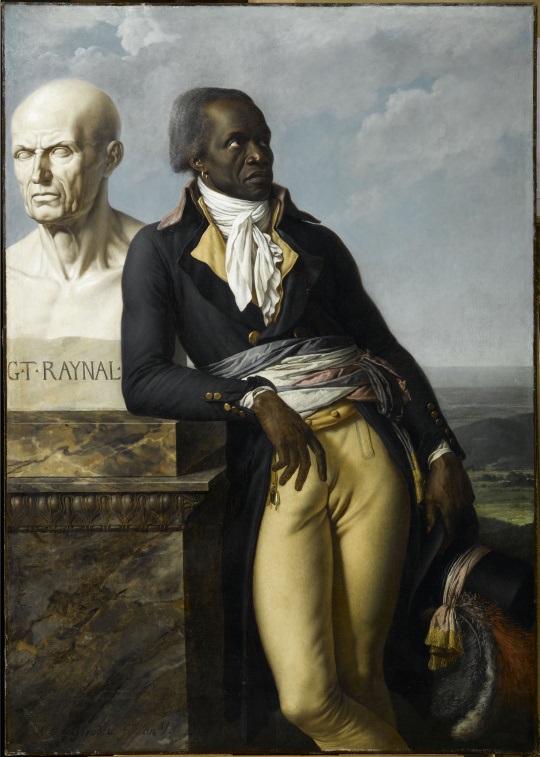
But if Vincent’s portrait of Roland was imbued with the democratic ethos of the Revolution, it also self-consciously positioned both sculptor and painter as members of a new cultural elite. Given the tumultuous changes the Salon had recently undergone, it was significant that Vincent gave his address in the Salon catalogue as “Palais national des Sciences et des Arts” and exhibited his portrait with the title “Le portrait du C. Roland, sculpteur, membre de l’Institut national des Sciences et Arts”44 — a title that mimicked the formula for portraits of academicians under the ancien régime.45 Vincent was emphasizing his and Roland’s shared professional status as members of the Institut, a body that would effectively become the new Academy, and he was doing so in the first Salon to be juried after several years of radical, and in many eyes failed, democratic experiment. Professional distinctions and high standards, and the new national institutions charged with maintaining them, mattered immensely to these men.46 Moderate Republicans both, they had paid their dues and risen through the ranks over the course of many years, and now they were identifying themselves with the meritocratic principles of the new order.
Telling in this connection is the honorific red ribbon conspicuously affixed to Roland’s jacket. This detail is likely a later addition that refers to the Légion d’honneur, the order of merit instituted by Napoleon in 1802. Roland became a chevalier in the order in 1806 and it may have been around that time that the ribbon was added, probably by Vincent himself (assuming that Roland was in possession of the portrait).47 Certainly the early 19th-century inscription on the back of the canvas emphasizes the importance of such marks of distinction: “Philippe Laurent Roland [,] sculptor [,] member / of the Legion of Honor, of the Institut de France [,] of the / former Royal Academy of Painting and Sculpture of Paris / and of several learned societies […].”48
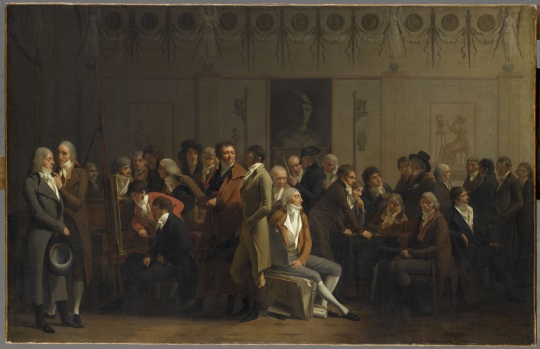
In the end, Vincent’s portrait of Roland did not attract much attention at the 1798 Salon. More than a third of the 442 paintings on display were portraits,49 and only a few standouts occupied the critics. Among these were the imposing portrait of Jean-Baptiste Belley (1746–1805), the first Black deputy of the Convention, by David’s pupil Anne-Louis Girodet de Roussy-Trioson (1767–1824) (fig. 4),50 and a small-scale group portrait by Louis Léopold Boilly (1761–1845), Gathering of Artists in the Studio of Isabey (fig. 5).51 The latter presented an informal cenacle of artists, mostly fashionable genre painters, who constituted a sort of youthful counterpart to the official Institut with its older, more established representatives. Quite a pronounced generation gap separates Vincent’s portrait from Boilly’s.
Vincent’s portrait was also overshadowed, it should be acknowledged, by his own major contribution that year, Agriculture, a painting that had occupied much of his attention since 1795 (fig. 6). Executed for a private patron in Toulouse, this large-scale work presented agricultural labor as the foundation of national prosperity and as a critical object lesson for an enlightened education. Part allegory, family portrait, genre scene, animal painting, and landscape, it eluded easy classification and was one of the artist’s, and indeed the entire period’s, most original paintings.52
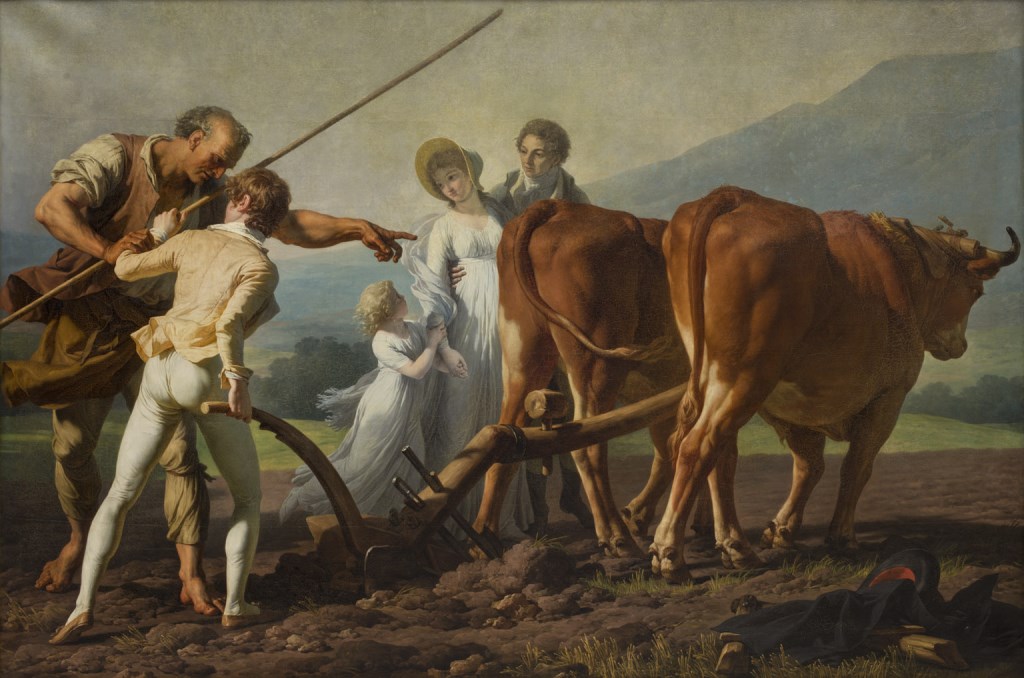
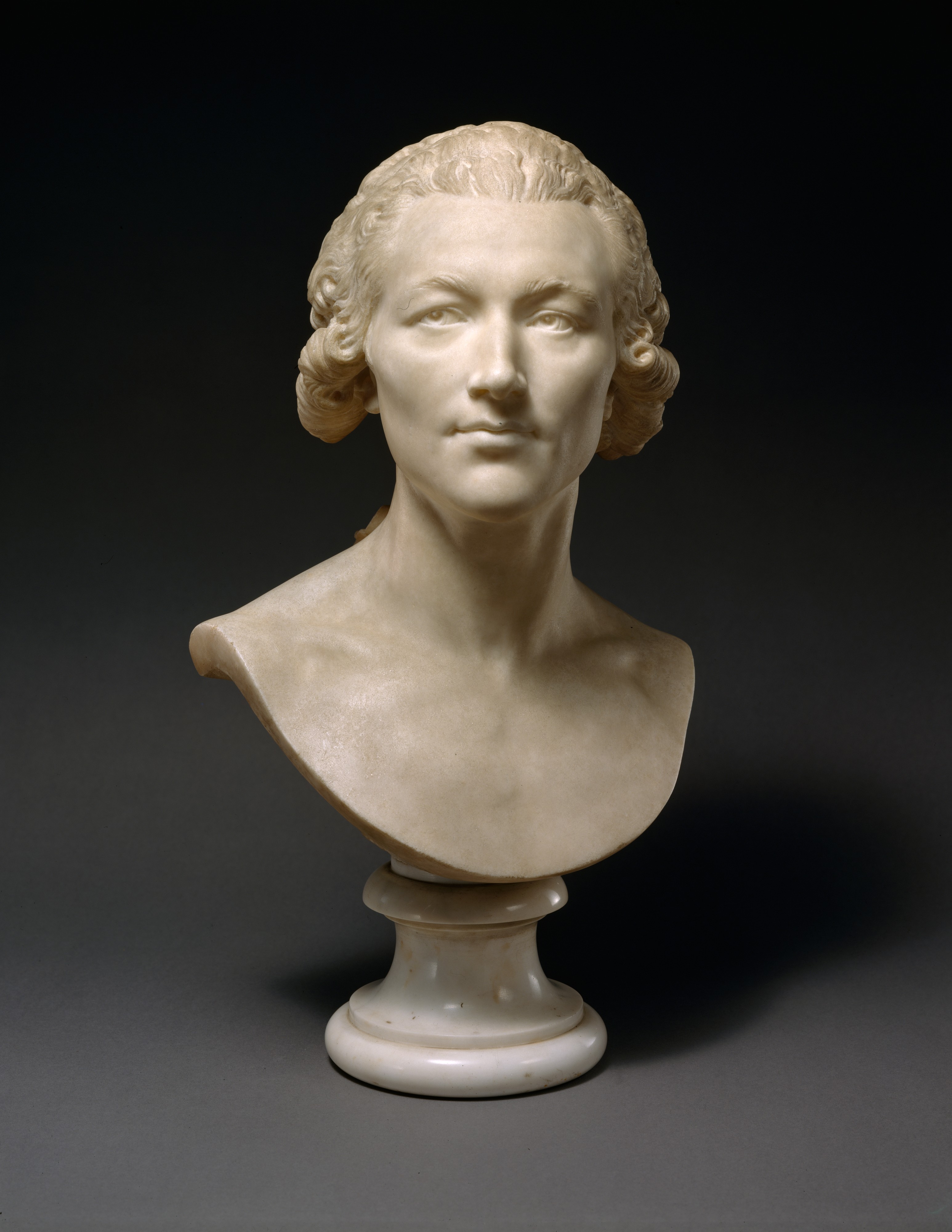
The portrait of Roland did nonetheless generate some discussion. One particularly mean-spirited “amateur” wrote: “It’s true to life, I don’t doubt it. It’s well drawn, who would dare doubt that? But this is not a good portrait.”53 No explanation was offered and the eminent Vincent scholar Jean-Pierre Cuzin has found the comment mystifying.54 It was, however, a minority opinion, which took exception to the fulsome praise for Vincent that appeared elsewhere. We read in the Journal d’indications, for instance:
Although one is less astonished to find the perfection of the portrait in a great history painter, one must nevertheless pay a tribute of admiration to an artist who unites with the highest degree of talent perfect resemblance with much strength and truth. To these combined qualities one also finds in the work of citizen Vincent that life which is the soul of portraiture. The artist has not just contented himself in rendering the face; he has also known how to express the character and spirit of the person.55
All that was missing, in this critic’s eyes, was a little more transparency in the shadows.
To convince ourselves of the “perfect resemblance” of Vincent’s portrait, we can consider it alongside a striking self-portrait bust by Roland, executed about a decade earlier (fig. 7).56 As for insight into Roland’s “character and spirit,” we are fortunate to have a firsthand physiognomic description written by Roland’s most famous pupil, David d’Angers (1788–1856):
Roland was of average height and delicate complexion. His ruddiness announced a sanguine temperament, but the nervous element predominated in him. His walk, although calm, partook of his moral energy. His movements were often brusque, his speech short. His head was developed, his forehead very broad…; his skull offered an extremely pronounced protuberance, that of perseverance. The features of his face bore the imprint of his habitual disposition of mind, the sharp and penetrating eyes like those of an artist, the mouth large but well delineated. Like men occupied with serious matters, he spoke little in his social relations. He showed a dignified reserve and loyal sincerity, heightened by a great austerity of principle.57
These invaluable words do much to bring the similarly dignified, reserved and sincere portrait by Vincent to life.
- Scott C. Allan
-
The painting is signed and dated, lower right: “Vincent an V / 1797 v px”. ↩︎
-
An inscription on the back of the painting elaborates on Roland’s standing: “Philippe Laurent Roland Statuaire membre / de la legion d’honneur, de l’Institut de France de la / cy devant académie Royale de Peinture et de Sculpture de Paris / et de plusieurs Société [sic] Savantes. Né à Perret le / 13 Aoust 1746 près de Lille dpt du nord / Peint par son amis [sic] Vincent, de l’Institut de France & c à Paris l’an 1797.” The date of this inscription is uncertain, but it must postdate 1806, the year in which Roland was inducted into the Légion d’honneur, which had been founded in 1802. Considering that only Roland’s birth date is given, the inscription probably predates 1816, the year of the sculptor’s death. ↩︎
-
For a late 18th-century illustration of various sculptural ébauchoirs, see the plate in Diderot and d’Alembert’s L’Encyclopédie: https://gallica.bnf.fr/ark:/12148/bpt6k99520/f76.item.texteImage (accessed October 7, 2020). ↩︎
-
Explication des ouvrages de peinture et dessins, sculpture, architecture et gravure, exposés au Muséum central des Arts, d’après l’Arrêté du Ministre de l’Intérieur, le 1er Thermidor, an VI de la République française (Paris: De l’imprimerie des sciences et arts, [1798]), p. 76, no. 426 (“Le portrait du C. Roland, sculpteur, membre de l’Institut national des Sciences et Arts”). ↩︎
-
On Vincent’s early formation, culminating in his Grand Prix win, see Jean-Pierre Cuzin, François-André Vincent, 1746–1816: Entre Fragonard et David (Paris: Arthena, 2013), pp. 13–20. Cuzin’s is the definitive monograph on the artist and this essay depends greatly on its exhaustive scholarship. ↩︎
-
Vincent spent the years 1768–1771 at the École des Élèves protégés; see Cuzin 2013 (note 5), pp. 21–23. ↩︎
-
On Vincent’s crucial Roman years, see Cuzin 2013 (note 5), pp. 27–75. ↩︎
-
Vincent was accepted into the Royal Academy in May 1777; see Cuzin 2013 (note 5), p. 85. ↩︎
-
L’Enlèvement d’Orythie, 1781–1782. Oil on canvas, 260 x 119.5 cm. Rennes, Musée des Beaux-Arts, inv. D.2007.1.1. See Cuzin 2013 (note 5), pp. 118–22, 439, no. 394P, ill. p. 121. ↩︎
-
Cuzin 2013 (note 5), p. 143. ↩︎
-
Cuzin 2013 (note 5), p. 184. ↩︎
-
Cuzin 2013 (note 5), p. 204. ↩︎
-
Cuzin 2013 (note 5), p. 235. ↩︎
-
Cuzin 2013 (note 5), p. 13. ↩︎
-
On Vincent’s relationship with Labille-Guiard, see Cuzin 2013 (note 5), pp. 16, 82, 84, 94, 128, 130, 170–71, 177, 184, 190, 196, 201, 231–32, 255–59. ↩︎
-
See Cuzin 2013 (note 5), pp. 64–73. Vincent undertook a similar group of portrait sketches when he was a member of the Institut; see Cuzin 2013, pp. 206–9. ↩︎
-
Portrait de Monseigneur Ruffo, 1775. Oil on canvas, 140 x 101 cm. Naples, Museo di San Martino, inv. 13 203. See Cuzin 2013 (note 5), pp. 62, 408, no. 280P, ill. p. 63. ↩︎
-
“Nos élèves travaillent tous avec zèle. Le sr Vincent a fait quelques portraits dernièrement, d’un très bon goût; il me paraît que ce sera la partie où il voudra le plus s’occuper.” Quoted in Cuzin 2013 (note 5), p. 62. ↩︎
-
Between 1777, the year of Vincent’s Salon debut, and 1801, his final Salon, he exhibited 14 works that were identified as portraits. These represent more than a quarter of his total Salon production, which amounted to at least 49 paintings. In the 1777 Salon, Vincent exhibited five portraits: no. 193, Portrait en pied de M. Bergeret, Honoraire-Amateur de l’Académie (Cuzin 2013 [note 5], no. 148P); no. 199, Portrait de M. Berthellemy, Peintre, Agrée de l’Académie (Cuzin 2013, no. *188P); no. 200, Portrait de M. Rousseau, Architecte, ancien Pensionnaire du Roi à Rome (Cuzin 2013, no. 187P); no. 201, Portraits d’Homme & de Femme, sous le même numéro (Cuzin 2013, nos. 318P, 319P). In 1781, he exhibited one portrait: no. 195, Le Portrait de M. l’Evêque de Saint-Diez (Cuzin 2013, no. *384P). In 1791, he exhibited two portraits: no. 4, Portrait d’Enfant jouant avec des cartes (Cuzin 2013, no. 496P); and no. 249, Portrait de M. Desforges, Auteur Dramatique (Cuzin 2013, no. 486P). In 1795, he exhibited four portraits: no. 529, Deux portraits d’Enfans (Cuzin 2013, nos. *535P, 536P); no. 530, Portrait de Femme (Cuzin 2013, no. *537P); and no. 531, Portrait de Femme (Cuzin 2013, no. *538P). In 1798 he exhibited the Getty painting, and in 1801 he exhibited one final portrait: no. 367, Portrait du cit. Arnault (Cuzin 2013, no. 622P). For a complete listing of Vincent’s Salon entries, see the “Chronologie” in Cuzin 2013, pp. 312–13, 314, 315, 317, 319, 322. ↩︎
-
See note 19, above. ↩︎
-
On Roland’s involvement in Pajou’s decorative projects in the 1760s, see Quatremère de Quincy, “Notice historique sur la vie et les ouvrages de M. Roland, sculpteur,” in Recueil de notices historiques lues dans les séances publiques de l’Académie royale des beaux-arts à l’Institut (Paris: Adrien Le Clere et Cie., 1834), pp. 103–4; David d’Angers, Roland et ses ouvrages (Paris: Pagnerre, 1847), p. 11; James David Draper, “Philippe-Laurent Roland in the Metropolitan Museum of Art,” Metropolitan Museum Journal 27 (1992), p. 129; James David Draper, “Pajou and Roland,” in Augustin Pajou et ses contemporains, ed. Guilhem Scherf (Paris: La Documentation française; Musée du Louvre, 1999), p. 539; and Guilhem Scherf, “Roland, Philippe-Laurent”[2003], in Grove Art Online, https://www.oxfordartonline.com/groveart/view/10.1093/gao/9781884446054.001.0001/oao-9781884446054-e-7000072779?print=pdf (accessed October 7, 2020). ↩︎
-
Draper 1999 (note 21), p. 540. ↩︎
-
Draper 1999 (note 21), pp. 541–42. ↩︎
-
Draper 1999 (note 21), 540–41. ↩︎
-
Draper 1992 (note 21), pp. 132–33; Scherf 2003 (note 21). ↩︎
-
Draper 1992 (note 21), p. 140; Draper 1999 (note 21), pp. 544–45; Scherf 2003 (note 21). ↩︎
-
Quatremère de Quincy 1834 (note 21), p. 107; Scherf 2003 (note 21). ↩︎
-
Quatremère de Quincy 1834 (note 21), pp. 108-9; Scherf 2003 (note 21). ↩︎
-
Quatremère de Quincy 1834 (note 21), p. 110. ↩︎
-
Scherf 2003 (note 21). This sculpture is untraced. ↩︎
-
Noteworthy among these are a plaster bust of the architect Jacques Guillaume Legrand in the 1787 Salon (no. 266) and a terracotta bust of the painter Joseph Benoît Suvée in the 1789 Salon (no. 261; Musée du Louvre, inv. N 15534). ↩︎
-
On this comparison, see also Cuzin 2013 (note 5), p. 221. For further discussion of Roland’s bust of Pajou, see Quatremère de Quincy 1834 (note 21), p. 111; D’Angers 1847 (note 21), p. 25; Draper 1999 (note 21), p. 539; and Scherf 2003 (note 21). ↩︎
-
On the democratizing reforms in the post-Revolutionary Salons, particularly in 1791 and 1793, see Udolpho van de Sandt, “Institutions et concours,” in Aux armes & aux arts! Les Arts de la Révolution 1789–1799, eds. Philippe Bordes and Régis Michel (Paris: Adam Biro, 1988), pp. 139–42; and Jean-François Heim, Claire Béraud, and Philippe Heim, Les Salons de peinture de la Révolution française, 1789–1799 (Paris: C.A.C. Sarl. Édition, 1989), pp. 16–22, 37–43, 45–49. ↩︎
-
In 1789, fifty-three painters exhibited 220 paintings; in 1791, 172 painters exhibited 615 paintings. The 1793 Salon saw a further increase: 258 painters exhibited 687 paintings. See Van de Sandt 1988 (note 33), p. 141, tables 1, 2. See also Heim, Béraud, and Heim 1989 (note 33), p. 17. ↩︎
-
In the late 1780s (1787 & 1789 Salons), for instance, portraiture constituted 21% of the paintings exhibited; by the late 1790s (1798 & 1799 Salons), it was 37%. See Van de Sandt 1988 (note 33), p. 142, table 4. See also Heim, Béraud, and Heim 1989 (note 33), p. 17. ↩︎
-
Heim, Béraud, and Heim 1989 (note 33), p. 19. ↩︎
-
Heim, Béraud, and Heim 1989 (note 33), p. 21. ↩︎
-
Van de Sandt 1988 (note 33), p. 157. ↩︎
-
See Heim, Béraud, and Heim 1989 (note 33), p. 19; and Van de Sandt 1988 (note 33), p. 157. ↩︎
-
442 paintings were exhibited in 1798, a significant reduction from the 687 in 1793, 534 in 1795, and 529 in 1796. See Van de Sandt 1988 (note 33), p. 141, table 2. ↩︎
-
In 1798, 12304 catalogues were sold; in 1796, only 6846 had been sold. See Van de Sandt 1988 (note 33), p. 142, table 5. ↩︎
-
Heim, Béraud, and Heim 1989 (note 33), p. 63. ↩︎
-
On the dramatic shifts in menswear toward the end of the 18th century, see Aileen Ribeiro, Dress in Eighteenth-Century Europe, 1715–1789 (New York: Holmes & Meier Publishers, Inc., 1985), pp. 143–49; Aileen Ribeiro, The Art of Dress: Fashion in England and France 1750 to 1820 (New Haven and London: Yale University Press, 1995), pp. 83–86, 94–95; and Pierre Arizzoli-Clémentel, “Les Arts du décor,” in Aux armes & aux arts! Les Arts de la Révolution 1789–1799, eds. Philippe Bordes and Régis Michel (Paris: Adam Biro, 1988), pp. 302–8. ↩︎
-
See note 4, above. ↩︎
-
A good example would be Roland’s portrait of Suvée (see note 31, above), which was exhibited in 1789 as “M. Suvée, Peintre du Roi, Adjoint à Professeur [his rank in the Academy].” ↩︎
-
As Cuzin has written, Vincent was “[un] homme d’ordre, homme d’institutions, [qui] a besoin de structures, de hierarchies.” Cuzin 2013 (note 5), p. 201. ↩︎
-
J. Paul Getty Museum curatorial file, email communications from Jean-Pierre Cuzin to Scott Allan, dated October 13 and October 15, 2020. ↩︎
-
See note 2, above. ↩︎
-
See notes 35 and 40, above. ↩︎
-
1798 Salon livret (note 4), p. 32, no. 194 (“Portrait du C. Belley, ex-représentant des Colonies”). See also Régis Michel, “L’Art des Salons,” in Aux armes & aux arts! Les Arts de la Révolution 1789–1799, eds. Philippe Bordes and Régis Michel (Paris: Adam Biro, 1988), p. 79; and Heim, Béraud, and Heim 1989 (note 33), p. 64. ↩︎
-
1798 Salon livret (note 4), p. 7, no. 39 (“Réunion d’Artistes dans l’atelier d’Isabey”). See also Michel 1988 (note 48); and Heim, Béraud, and Heim 1989 (note 33), p. 65. ↩︎
-
1798 Salon livret (note 4), p. 75, no. 425 (“L’Agriculture”). For a thorough discussion of the genesis and reception of this important work, see Cuzin 2013 (note 5), pp. 214–20. ↩︎
-
“C’est ressemblant; je n’en doute pas. C’est bien dessiné; qui oserait en douter? mais ce n’est pas un bon portrait.” [François Joseph Aloyse Doix], Itinéraire critique, du Salon de l’an VI. Dédié aux artistes, par un Amateur (Paris, [1798]), p. 21. ↩︎
-
As Cuzin has argued in defense of Vincent’s portrait: “Ce n’est pas un bon portrait, c’est un portrait admirable.” Cuzin 2013 (note 5), p. 221. ↩︎
-
“Quoique l’on soit moins étonné de trouver la perfection du portrait chez un grand peintre d’histoire, l’on ne doit pas moins payer un tribut d’admiration à l’artiste qui réunit au plus haut degré de talent une ressemblance parfaite, beaucoup de force et de vérité; à ces qualités réunies on trouve encore dans l’ouvrage du citoyen Vincent cette vie, l’âme des portraits. L’artiste ne s’est point contenté de rendre le visage, il a su encore exprimer le caractère et l’esprit de la personne. On aurait souhaité qu’à ces différentes beautés qu’un pinceau hardi a exécutées, il eut joint plus de transparence dans les ombres.” Exposition de peintures, sculptures, architecture, gravures et dessins. Journal d’indications 1798. MS transcription from the Journal d’indications. Bibliothèque nationale de France, département Estampes et photographie, RESERVE 8-YA3-27 (20, 541) [Collection Deloynes, tome 20, pièce 541], pp. 209–10. ↩︎
-
For further discussion of this self-portrait, see Daniëlle Kisluk-Grosheide and Jeffrey Munger, The Wrightsman Galleries for French Decorative Arts, The Metropolitan Museum of Art (New York: The Metropolitan Museum of Art, with Yale University Press, 2010), pp. 183–84, no. 91. ↩︎
-
“Roland était d’une taille moyenne et d’une complexion délicate, son teint très-coloré annonçait un tempérament sanguin; mais en lui l’élément nerveux prédominait. Sa démarche, quoique posée, participait de son énergie morale; il avait les mouvements souvent brusques, la parole brève, la tête développé, le front très-large par le haut; son crâne offrait une protubérance extrêmement prononcée, celle de la perséverance. Les traits de son visage portraient l’empreinte de la disposition habituelle de son esprit, les yeux vifs et pénétrants comme ceux de l’artiste, la bouche grande, mais bien dessinée. Comme les hommes occupés de choses sérieuses, il parlait peu dans ses rapports sociaux; il apportait une réserve digne et une loyale franchise, que rehaussait une grande austérité de principes.” D’Angers 1847 (note 21), p. 38. ↩︎